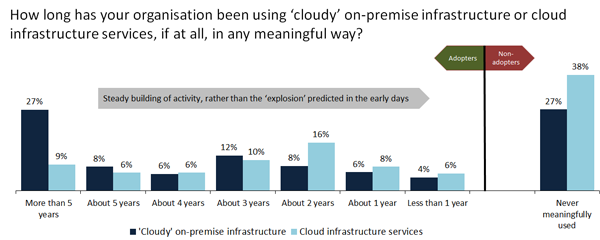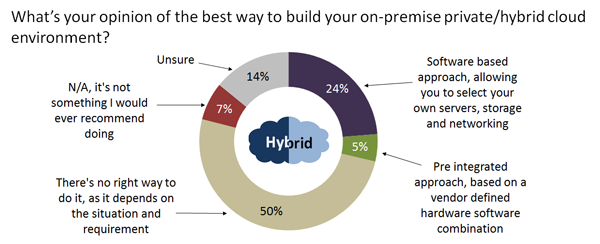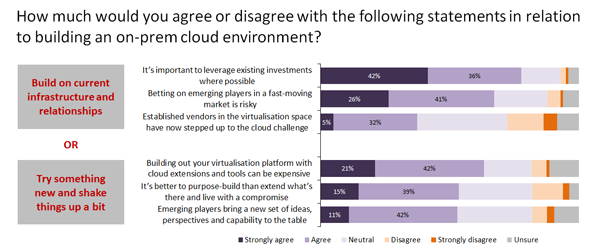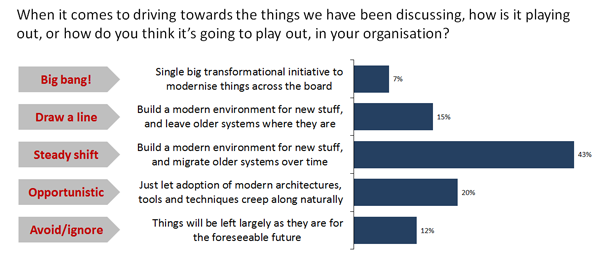This article is more than 1 year old
Cloud computing is bigger than AWS and Azure
Reg readers look forward to a hybrid reality
Research To some, cloud computing is synonymous with so-called ‘public cloud’ services such as AWS and Azure, but this isn’t the view of Reg readers. When 668 of you provided feedback during a recent survey on meeting infrastructure-level needs, the adoption of ‘private cloud’ (defined as ‘cloudy architecture running in your own data centre’) was what came through most prominently:

What’s also clear from this picture is that evangelical claims of everyone now having a ‘cloud first’ strategy greatly overstate the level of commitment out there. Many organisations are still in the investigation or planning stage in relation to different types of cloud and use cases, and while most of the remainder are open-minded in each area, a significant level of scepticism persists.
Looking at adoption in a different way, we see that all those phrases suggesting a rapid market shift – ‘cloud explosion’, ‘stampede to the cloud’, etc. – are also considerably overstated. The reality is that adoption over the last five years or so would be better characterised as a slow burn:

The other key observation is that even when you look across all the use cases listed above (as that last chart does), there are still quite a few organisations yet to do anything meaningful with infrastructure-level cloud, particularly in relation to public cloud services.
Implicit in the data presented is the notion that most organisations active with cloud are mixing and matching solutions and services: generally speaking, the requirement to support hybrid environments came through very strongly. This leads to the need for a range of capabilities that enable harmonious and efficient coexistence of different cloud flavours. An example that clearly illustrates this is workload migration:

The same principle – of aiming for coherency across all the internal and external clouds you use – applies to management and monitoring, access security, data protection, application integration, and all of the other things that are important for maintaining integrity and flexibility, and preventing runaway costs and risks.
And as illustrated on the chart, when thinking about this we need to interpret the word ‘hybrid’ in its broadest sense. It’s not just about getting on-premise systems working together with hosted services, it’s about acknowledging the reality of dealing with multiple cloud environments and instances running in your own data centre, while simultaneously exploiting multiple public cloud services, and even those more traditional forms of infrastructure and hosting.
This is where the latest generation of private/hybrid cloud solutions come into play. The idea of these is to create a platform or framework that provides on-premise cloud capability in its own right, but also represents a single point of coordination for effective management and operation of the various clouds you adopt. Get it right, and the result is freedom and flexibility, e.g. to move workloads around freely and make sure a given application is always running in the most appropriate cloud, based on its performance characteristics, compliance requirements, economics, and so on.
Of course, this is easier said than done, particularly in a larger and more complex environment where you will generally end up with more than one hybrid cloud platform. Even then, however, it’s better to have a discrete number of properly managed hybrid setups than a sprawling, disjointed mishmash of private and public cloud instances, which is the obvious danger, given the way many organisations are headed.
The good news and the bad news is that the IT vendor community have pretty much all gone hybrid cloud crazy at the moment, which means lots of choices, but also lots of hype and spin to work through. At the 40,000 feet level, one of the big debates is whether you should take a pure software-based approach to building your hybrid environment, or take advantage of the growing range of pre-integrated hardware/software stacks or appliances.
When considering this question, Reg readers who have a firm preference tend to lean towards the software-based approach, though the most common view is that you should keep your options open because requirements will vary:

The other big question is whether you should turn to virtualization platform incumbents such as VMware and Microsoft, or give a chance to newer players, which claim to approach the problem with a fresh mindset and no baggage. This isn’t an easy decision as there are pros and cons in each direction:

What most readers agree on is that whichever way you go, it makes sense to structure and pace your hybrid-cloud activity in a proactive but considered manner:

And so the slow burn of cloud computing adoption continues, though we hope in a more joined up and organised way.
If you are interested in seeing the complete set of findings from the study, and reading a more in-depth discussion of hybrid-cloud practicalities, you can download the full research report here.
